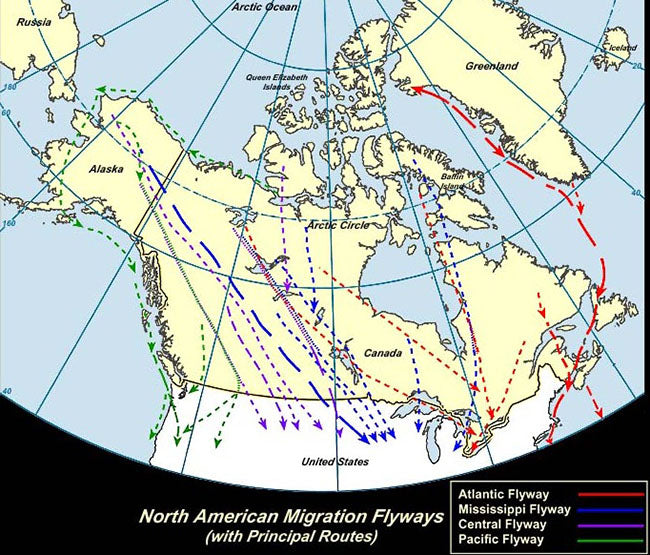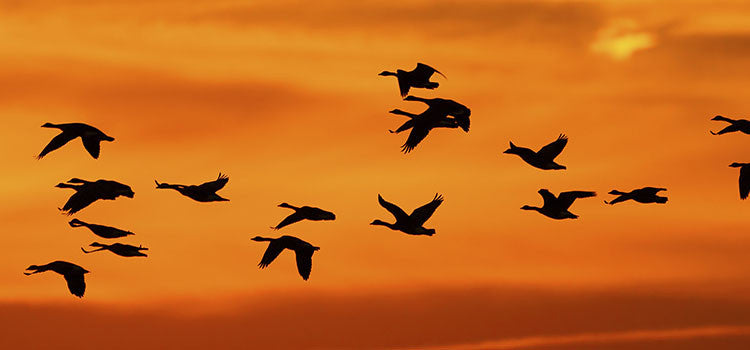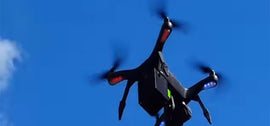Geese, ducks, swans, wigeons, cranes and other migratory waterfowl cause millions of dollars in damage to crops. Grass seed, winter wheat, alfalfa, corn, soybeans, rice, and lettuce are all susceptible to damage by grazing waterfowl. Mergansers, mallards, and black ducks cause problems at some aquaculture facilities by feeding on fish fry and fingerlings. Common eiders and black and surf scoters cause problems when they feed in commercial blue mussel and razor clam beds
The Flyway Systems:
The routes followed by migratory birds are numerous and while some of them are simple and easily traced, others are extremely complicated. Differences in distance traveled, in time of starting, in the speed of flight, in geographical position, in the latitude of the breeding and wintering grounds and in other factors all contribute to great diversity. No two species follow exactly the same path from beginning to end; geographical groups of species with an almost continental distribution may travel different routes.
Bird migration is generally thought of as a north-and-south movement, with the lanes of heavier concentration following the coasts, mountain ranges and principal river valleys. In general, it may be said that the great routes of migration do conform very closely to major topographical features when these happen to lie in the general direction of the travel to be performed. It happens to work out nicely in North America where the coasts, mountain chains and come of the larger rivers do not depart from a north-and-south alignment. 
The terms "migration route" and "flyway" are to some extent theoretical concepts, while the latter has, in addition, come to have an administrative meaning. Migration routes may be defined as the lanes of individual travel from any particular breeding ground to the winter quarters of the birds that use them. Flyways, on the other hand, may well be conceived as those broader areas in which related migration routes are associated or blended in a definite geographic region. They are wide arterial highways to which the routes are a tributary.
There are four (4) major North American flyways that have been named the Atlantic, the Mississippi, the Central and the Pacific Flyways. Except along the coasts, the flyway boundaries are not always sharply defined and both in the northern breeding and the southern wintering, grounds there is more or less overlapping. As a matter of fact, in the region of Panama, parts of all four flyways merge into one.
The thing we hear most frequently when talking to potential clients is “we have tried everything and nothing works”. Some of the things that make migratory birds difficult to control are the large acreage of the fields that can be compromised as well as the fact that these birds fly in huge flocks and may fly in at night. Birds that fly in at night can cause immense damage before you even know the birds are there.
There is some good news. Flock Free Bird Control has been working with our development partners to introduce technologically advanced methods to control migratory birds. The products that we work with are effective and Flock Free Bird Control does not continue to promote products that do not achieve results. Flock Free Bird Control promotes Integrated Bird Control (IBC) that teaches the use of combinations of successful products that teach birds to stay away. The only way to deter birds is to add layers of stress that irritate birds beyond their comfort zone.
The following products would be prescribed depending on the kind of bird, crop affected, the acreage of damage and other factors given not all products can be used in all areas.
Tank Mix is a simple and extremely effective product that works great on the most species of birds for the protection of virtually any kind of property. Just spray it with any sprayer once per week for the first 4 weeks and then once per month. It will irritate birds when they touch it or inhale it. At the same time, it's an organic-based product that does no harm to birds and may be safely used around people and animals.
Hazers are highly effective on geese and other large waterfowl and were developed by Flock Free Bird Control and emit an invisible, lighter than air haze of 40% methyl anthranilate, a food-grade grape extract that is acidic and irritates the trigeminal nerve in the bird’s beaks. Our solar-powered hazers are very safe and can be highly effective in many applications. Methyl anthranilate is organic in composition but does not have any organic registrations.
Vortex Ring Avian Deterrent (VRAD) As you can see from the following photos, the VRAD is not a canon. It is something far more impressive and effective. The Vortex Ring Generator actually produces a Vortex Ring that acts as a projectile traveling through the air. In addition to a fierce concussion, an intense “bang” and a shock wave, the vortex ring travels through the air ringing and screaming past the point where humans can hear it. A vortex is formed when fluid (the fluid in our case being air) flows back on itself, making a spinning ring around an invisible core. The vortex ring produces little resistance as it moves through the air allowing it to travel long distances. The Vortex Ring acts as a projectile and may actually hit birds (without harming them) adding to the fear level. Can be set up to fire automatically.
Drones – Drones are in development for many applications and we believe they will be an effective bird deterrent in many scenarios. The major use for us will be as a teaching tool. Sonic Nets and Hazers, for example, are invisible. Sonic Nets block communication and Hazers irritate the bird’s trigeminal nerve. Adding a drone to either of these will make them more effective as birds learn to associate the visible (Drone) with the invisible irritation.
Sonic Nets were developed at the College of William and Mary and have been tested at the University level for a few years. As opposed to sound systems designed to “scare” birds, Sonic Nets broadcast background noise at the same frequencies birds communicate - disrupting their ability to communicate - thereby creating an environment where they are highly uncomfortable. Most birds in crops are by nature prey animals so communication is vital to their survival. Not being able to send distress calls makes them very uncomfortable and causes them to look for more suitable areas. Sonic Nets are now guaranteed to reduce the time birds spend eating and damaging crops by 85%.
Feel free to reach out to us with questions or concerns.


